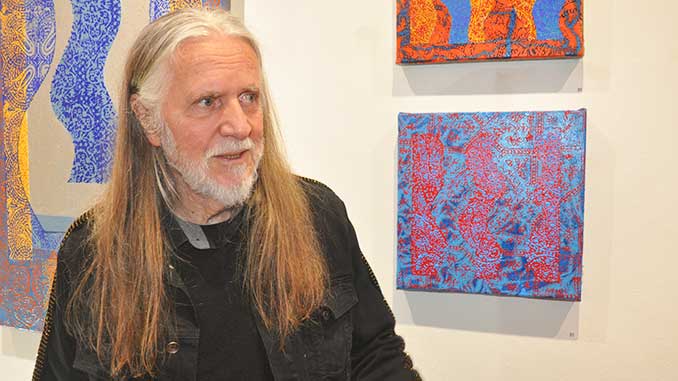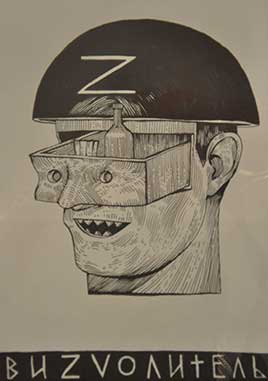 Melbourne painter George Gittoes can’t stay away from war zones. He has two exhibitions on at the moment, one a collaboration with a Ukrainian artist and the other with Taliban connections.
Melbourne painter George Gittoes can’t stay away from war zones. He has two exhibitions on at the moment, one a collaboration with a Ukrainian artist and the other with Taliban connections.
He launched his Taliban show on Saturday with a story about the danger of border crossings. Once he was thrown into a small, dark room in Afghanistan and had to talk his way out.
“We ended up hugging each other,” he says of his jailer. “I said look into my eyes and tell me if I have done anything wrong.”
Gittoes ended up apologising for Australian actions in the war-torn country and continuing on his way.
Doorways at One Star gallery is an exhibition of oil paintings that combine Afghani patterns with portraits of local people from Gittoes’ Yellow House creative project in Jalalabad.
Sales from the paintings will go towards supporting the project, which has no other funding, just the talent of Gittoes and his wife for drumming up enthusiasm amongst other creatives.
Gittoes began as an abstract painter with an impressive genealogy of contacts in his formative years, including the US critic Clement Greenberg. He was also part of the first Yellow House project in Sydney with the irreverent cartoonist Martin Sharp.
 After travelling to the United States, he moved in a more figurative direction and his recent drawings and paintings in Ukraine, on show at Deakin University, are loose, powerful and descriptive.
After travelling to the United States, he moved in a more figurative direction and his recent drawings and paintings in Ukraine, on show at Deakin University, are loose, powerful and descriptive.
They dig deep into the pain of that country as it deals with the Russian invasion. One painting, House Where Children Lived, records the sight of a destroyed house in the city of Borodyanka.
Gittoes and his partner Hellen Rose spoke of the strangeness of crossing the border into Ukraine at a time most people were travelling in the opposite direction.
“The galleries are still open in Kyiv,” Rose says. “The artists aren’t giving up. We want to support them.”
Gittoes first went to Afghanistan as an official war artist and members of the defence forces are still following his career.
One former Australian army officer, at the One Star opening, reminisced about meeting Gittoes: “‘You’ve got an arts degree. You can show him around,’ I was told by my commanding officer.”
 War artists typically makes personal observations that provide alternative readings to the official view of occupied countries. Gittoes goes one step further and works with local artists as well. The superb drawings of Ave Libertatemaveamor, on display at Deakin, show an insider’s view of the mentality of Russian soldiers.
War artists typically makes personal observations that provide alternative readings to the official view of occupied countries. Gittoes goes one step further and works with local artists as well. The superb drawings of Ave Libertatemaveamor, on display at Deakin, show an insider’s view of the mentality of Russian soldiers.
Gittoes said that many of the preconceptions Australians have about the Taliban are biased. He told the One Star audience that every father he met in Afghanistan, now under Taliban rule, wanted his daughters to get an equal education.
The role of the war artist is to bear witness and Gittoes likes to view himself as a war correspondent. He keeps diaries and take documentary photographs of his journeys.
At the age of 74, he is not giving up his practice. The next destination on his itinerary is Gaza. He quotes Picasso in his catalogue: “Painting is not done to decorate apartments, it is an instrument of war.”
George Gittoes: Doorways
One Star Gallery, 301 – 303 Victoria Street, West Melbourne
Exhibition continues to 21 July 2024
Information: www.gittoes.com
George Gittoes: Ukraine Guernica
Deakin University Art Gallery, Building FA, 221 Burwood Highway, Burwood
Exhibition continues to 16 August 2024
Information: www.deakin.edu.au
Images: George Gittoes at the opening of Doorways at One Star Gallery – photo by Rhonda Dredge | George Gittoes, House Where Children Lived, 2022 (supplied) | Ave Libertatemaveamor, Kiss of Death, pen, pencil and marker (supplied)
Words: Rhonda Dredge
